In much of North America–indeed, in much of the world, winter is a time for looking at large numbers of common species. In my part of the world, in central Maryland, thousands upon thousands of Canada Geese augment our year-round populations, and a birder could easily spend hours sifting through them, marveling at the astounding numbers. Another group that explodes here in winter are the gulls. Ring-billed Gulls, especially, flood urban and rural areas alike, loafing on open water, parking lots, and agricultural fields. They are probably the default gull, perhaps even the default water bird, in most of Maryland throughout the year, a status which is solidified in winter.
One might think that such a cosmopolitan species would, therefore be among the most familiar and recognizable birds in the region. To some extent, that’s true. However, there are few more variable species of bird than those of the gull genus Larus, to which the Ring-billed Gull belongs. The Ring-billed is a perfect example of this variation, and a great species to use to show how, despite being among the most frustrating groups to learn about, gulls are also among the most fascinating and enjoyable.
So what does a Ring-billed Gull (RBGU from here out) actually look like? The answer to that question can be as simple or complicated as you want to go. The standard-issue, adult, RBGU in winter has a pale gray back and wings, white body and head, and yellow legs, eyes, and bill. The head is streaked or spotted lightly with dusky gray-brown, the wingtips are jet black with large white spots on them, and the bill has a characteristic black ring about 2/3 of the way out to the tip. It’s a mid-sized bird, but on the mid-to-small end for a gull, especially a Larus gull. It has long-ish legs, long wings, and a well proportioned head that is fairly rounded with a slim, average-length bill. Overall, an adult RBGU looks relatively slender, neat, and clean.

This is about as close to average as a RBGU gets. This adult bird has neat streaking that is limited to face and crown, a pale gray back, yellow legs, a crisply patterned bill, and a pale yellowish iris
In flight, the effect is very similar. The relatively small head, slender body, and long wings of the RBGU gives it a long-limbed look. The bird lacks the barrel chest of other, larger gulls, and the small head combined with long, slim wings makes it look far lighter-weight. The black wingtips retain the line of white spots, with two larger white spots, known as “mirrors” being revealed on the spread wing.
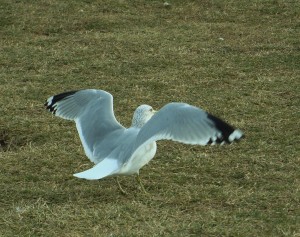
The spread wings reveal limited black at the tip of the wings, a line of white spots along the back edge of the wing, and two white mirrors on the two, outermost primary feathers (wingtip feathers)
All on its own, that doesn’t sound too bad. When compared with other gulls, there are similarities, but plenty of distinctions in shape and size and coloration to help distinguish RGBUs from other species. The difficulties start to come in when you consider all the things that can be different from our “average” gull outlined above. Lets start with some of the more consistent changes we can see.
Age is probably the greatest variable in gull identification. Oftentimes, when scanning a large group of gulls, of any species, you will noticed that many of them do not have the smooth, gray-and-white pattern that is expected. Many of them have underparts that are strongly spotted or barred, and the backs may be primarily brown. These birds are most often not, as is sometimes assumed, a different species but different ages of the predominating species. RBGU have three fairly distinct age groups, and many variations of those groups. One group, the adults, have largely been discussed already. The other, most distinct group, is that which includes birds which less than a year old, birds known as first-cycle birds. Shape and size-wise, they are largely identical to adults, but their plumage is worlds away. The white body feathers are barred and smudged with brown, sometimes quite liberally. They have a neat black band across the end of the tail, their dark wingtips lack the white spots and mirrors of adults, and their wings and backs are marked with brown-and-white bars and cross-bars. The closer they get to their first birthday, generally, the more gray they begin to show on the back and wings. The “bare parts” colors are also different than on adults. The eyes are dark blackish-brown, as is the bill. Both gradually turn pale, with the bill often having a pinkish base (as in the photo below) by the time the bird is a few month old. The legs are pink.
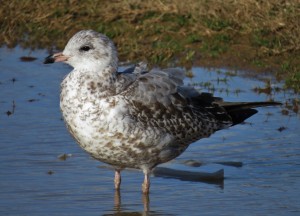
This is a fairly normal looking first-cycle bird. This bird has rather extensive and heavy brown markings across its entire body, but it is starting to show some of the cleaner gray adult feathers on its back. The wing feathers are very neat and sharply patterned, a product of their newness. Dark eyes and pink legs are characteristic of this age as well. The black on the bill is now largely limited to the tip, as the base is mostly pinkish.
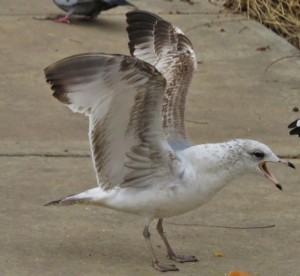
When looking at a first-cycle bird with a spread wing, the black on the wingtips is much more extensive than on an adult, and the primaries lack the white spots and mirrors, as well. The brown barring and mottling is apparent on both the upperside of the wing, and the underside.
The other age group is that which encompasses second-cycle birds–birds that are a year old. Their plumage is a mixture of adult and immature feathers. The back is often more completely gray than first-cycle birds, and the underparts and head often whiter. The wing tends to have more gray feathers, and wingtips may have small white spots. However, there are often still isolated dark bars or spots on the flanks and chest, and a few sets of barred, brown-and-white wing feathers usually remain. The bare parts colors are somewhat variable. The bill and legs may begin to turn yellow at this age, but they often have a fleshy, peachy, coloration. The tends to have neat black tip. Eyes are generally still dark, though this is somewhat variable. This is probably the most variable age, and some birds that are late in their first-cycle can look similar.

This is a more classic-looking second-cycle bird. The back is mostly gray, but there are some retained, brownish wing-coverts. They are relatively pale, the color bleached out of them due to their old age, but they are still evident. The wingtips are plain black, and the eye is still dark. The bird has fairly heavy markings on the chest and head, but it is whiter than the first-cycle birds. The bill is a striking, peachy color and the black bill tip is crisp. The eye remains dark.

This bird is a good example of the ambiguities that sometimes arise in ageing and identifying gulls. The eye is dark, so its not an adult. The bill is rather dark, with little pink, and certainly none of the fleshy peach color of the prior bird. However, the gray on the back is extensive, and its is extensively, but faintly marked below. My guess is that this is an early second-cycle bird. I don’t think those brown wing coverts and trials would be so frayed and bleached if this bird were under a year old.

Two adult RBGU… Or not? The back bird has a remarkably dark iris if it’s an adult, and the bill doesn’t look as bright yellow as the front bird. So is it a second-cycle? If it is, the gray on the back is remarkably extensive, and there is precious-little barring on the breast. Sometime gulls just don’t do what their supposed to, one of the things that can make them frustrating to learn. I would consider this bird an adult, but a new adult, one that has probably just shed the last of its second-cycle plumage.
The next set of variation I’ll look at is head shape. The standard RBGU is often described as pigeon-headed. The crown is rounded, the forehead is moderately steep, and the bills is rather slim but not overly long. A number of birds show that shape, but a reasonable number do not. The photo below is a great example:
Notice the difference in head shape between the front bird and the back one. The front bird looks like its head is more angular and flatter-crowned than the back bird, and the bill looks longer. It is a head shape that is vaguely reminiscent of the Herring Gull, a much larger Larus species. Recently, I sent this picture to a more experience gull-watcher for his thoughts. He mused that male and female gulls actually differ subtly in shape. The front bird with the flat crown, more sloping forehead, and thus longer-looking bill has a head shape he says is associated, anecdotally, with male RBGU. The RBGU we are familiar with in field guides, and the bird in the back of this photo, is the round-headed, neat-billed female bird.
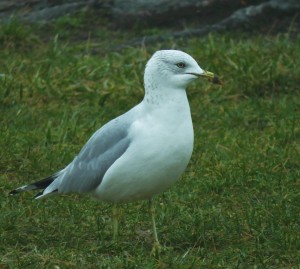
Another RBGU with a rather angular head. The more one looks at large numbers of these birds, the more apparent it is that small variations are the norm, and not the exception
Head pattern is another thing that is remarkably variable. The normal head patterning for older (late second-cycle into adult) birds is even, neat streaking across the head, often with slight concentrations of streaks around the eyes and crown. But often times, for no apparent reason, this streaking is nonexistent, almost as if the bird had molted into summer plumage already, but other times, it is so dark and extensive it gives off a hooded pattern. This is just something that needs to borne in mind. There isn’t really an explanation or trick to it, it just is.
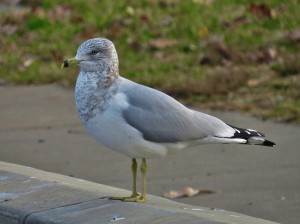
This bird has extensive dark streaking that extends from the crown to the nape of the neck, and down across the birds breast. In addition to its somewhat extreme extent, it is also smudgier than “normal”. The paler throat imparts a hooded appearance. All the same, it is still a RBGU, and adult bird too. See if you can tell why.
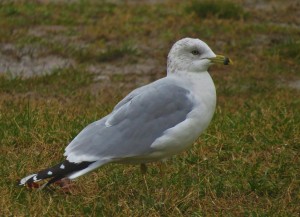
This bird is probably less heavily marked than average, but is close to the middle. The streaking is well-defined and occurs in three areas–around the eyes, the nape of the neck, and the crown. This is an often-seen pattern on RBGUs of any age, but especially adults, like this bird.

If you just saw this photo with no other info, you would probably think it had been taken in June. But winter birds are sometimes this pale on the head. Only the faintest lines of streaks on the forehead, and behind the eye are visible.
So the moral of the story? Gulls are variable, weird, and they don’t follow the rules we prescribe for them a lot of the time. However, they are also attractive and ubiquitous members of the birdlife in most regions so it pays to get used to looking at them, and figuring their quirks out. RBGUs are just one example of the variability that gulls show, but this post could have been written about most any species of gull. Gulls are fun, and the more you learn about them, the easier to understand they become.

